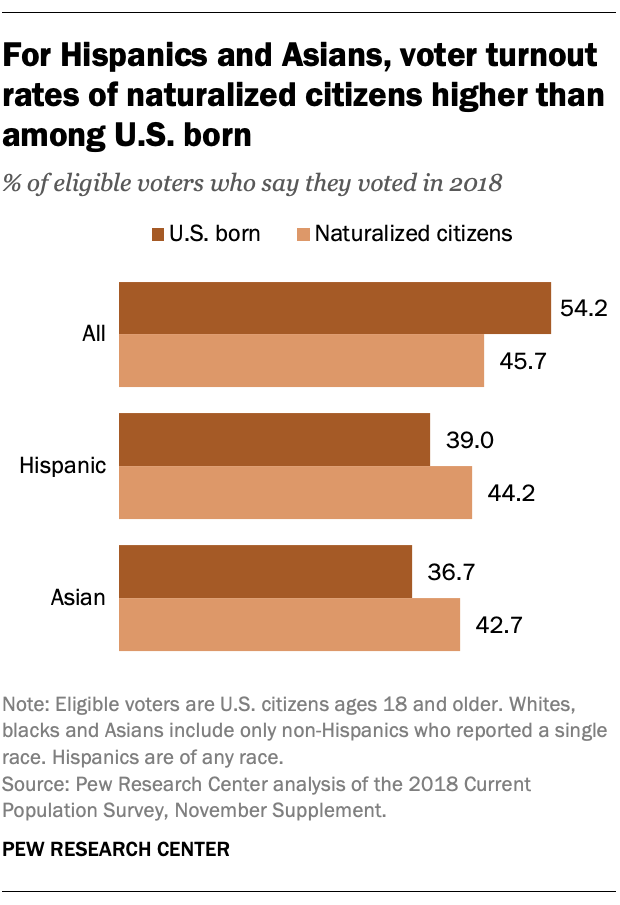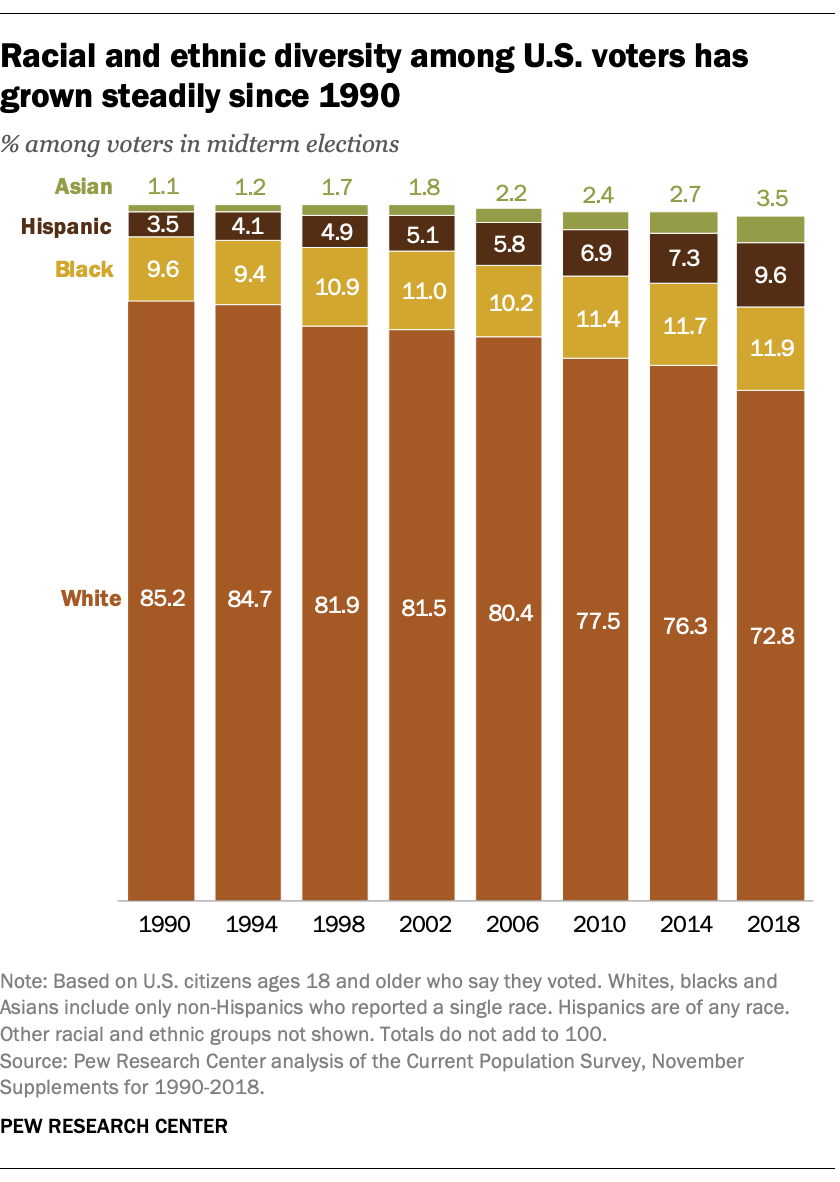More than half of U.S. eligible voters cast a ballot in 2018, the highest turnout rate for a midterm election in recent history, according to a Pew Research Center analysis of newly released data from the U.S. Census Bureau. The increased turnout was particularly pronounced among Hispanics and Asians, making last year’s midterm voters the most racially and ethnically diverse ever.
With enthusiasm at a record high, more than 122 million people voted in the 2018 elections, the highest in a midterm election year since 1978. Last year also marked the first time since 1982 that the voter turnout rate in midterm elections surpassed 50%. This was a stark reversal from the previous midterm year, when turnout had decreased – from 45.5% in 2010 to 41.9% in 2014. (The voter turnout rate is the share who cast a ballot among eligible voters, defined as U.S. citizens ages 18 and older. Historical data in this analysis starts in 1978, the first year the Census Bureau gathered citizenship data for its survey of voters.)
Here are key takeaways on voter turnout by race and ethnicity during the 2018 elections:
The Census Bureau’s biannual Current Population Survey November Voting and Registration Supplement is the best postelection survey of voting behavior available because of its large sample size and its high response rates. It is also one of the few data sources that provides a comprehensive demographic and statistical portrait of U.S. voters.
(Official voting records provide actual individual-level turnout data, but they do not contain voters’ full demographic details. Pew Research Center and other organizations match voter file data to surveys, providing another high-quality source of this information.)
But estimates based on the CPS November Supplement often differ from official voting statistics based on administrative voting records. This difference has been attributed to the way the CPS estimates voter turnout – through self-reports (which may overstate participation) and a method that treats nonresponses from survey respondents as an indication that the survey respondent did not vote (which may or may not be true).
To address overreporting and nonresponse in the CPS, Aram Hur and Christopher Achen in a 2013 paper proposed a weighting method that differs from the one used by the Census Bureau in that it reflects actual state vote counts. As a result, voter turnout rates reported by the Census Bureau (and shown in this analysis) are often higher than estimates based on this alternative weighting approach.
For example, tabulations using this adjustment and reported by Michael McDonald of the University of Florida produce a Hispanic national voter turnout rate of 36.9% for 2018, 3.5 percentage points below the Census Bureau’s official estimate of 40.4%. For non-Hispanic whites, the adjusted voter turnout rate is 55.2% in 2018, 2.3 points lower than the Census Bureau estimate.
No matter the method used, voter turnout rates in 2018 were the highest for a midterm election measured using the November Voting and Registration Supplement. Under both measures, the voter turnout rate in the 2018 midterms for all the referenced racial and ethnic groups increased to historically high levels.
1 All major racial and ethnic groups saw historic jumps in voter turnout. Hispanics and Asians each saw their turnout rates increase to about 40%. For both groups this was about a 13 percentage point increase over 2014, when turnout rates had declined to record lows for a midterm election year. Meanwhile, voter turnout rates for whites (57.5%) and blacks (51.4%) increased by 11.7 and 10.8 percentage points, respectively, since 2014. Voter turnout rates among all groups remained below levels typically seen in presidential election years.
All major racial and ethnic groups saw historic jumps in voter turnout. Hispanics and Asians each saw their turnout rates increase to about 40%. For both groups this was about a 13 percentage point increase over 2014, when turnout rates had declined to record lows for a midterm election year. Meanwhile, voter turnout rates for whites (57.5%) and blacks (51.4%) increased by 11.7 and 10.8 percentage points, respectively, since 2014. Voter turnout rates among all groups remained below levels typically seen in presidential election years.
2 The number of Latino voters nearly doubled from 2014 to 2018, nearing presidential election year levels. Overall, Latino voter turnout reached 11.7 million in 2018, up from 6.8 million in 2014 – the single largest increase on record from one midterm election to another. In fact, turnout among Latinos is the second-largest of any election year, presidential or midterm, trailing only the 2016 presidential elections. About 29 million Latinos were eligible to vote in 2018, up from approximately 25 million in 2014.
The number of Latino voters nearly doubled from 2014 to 2018, nearing presidential election year levels. Overall, Latino voter turnout reached 11.7 million in 2018, up from 6.8 million in 2014 – the single largest increase on record from one midterm election to another. In fact, turnout among Latinos is the second-largest of any election year, presidential or midterm, trailing only the 2016 presidential elections. About 29 million Latinos were eligible to vote in 2018, up from approximately 25 million in 2014.
Hispanic turnout in 2018 was consistent with substantially greater interest in the election compared with four years earlier: Prior to the midterms, 52% of Hispanic registered voters said they were giving “quite a lot” of thought to the elections, up from just 35% in 2014.
3 Among Latinos and Asians, the voter turnout rate in 2018 for naturalized citizens was higher than among the U.S. born. The naturalized-citizen turnout rate among Latinos was 44.2%, higher than the 39.0% turnout for U.S.-born Latinos. (Naturalized citizens are immigrants who have become U.S. citizens. Latinos and Asians are the nation’s two largest immigrant groups.) This gap between the Latino groups narrowed from 2014, when turnout was 35.2% and 24.2%, respectively. For Asians, naturalized citizens had a turnout rate of 42.7% compared with 36.7% for those born in the U.S. Those figures are up from 29.6% and 22.4% in 2014. Among all U.S. eligible voters, by contrast, the 2018 turnout rate of naturalized citizens trailed that of the U.S. born, 45.7% to 54.2%, a similar pattern as in recent elections.
Among Latinos and Asians, the voter turnout rate in 2018 for naturalized citizens was higher than among the U.S. born. The naturalized-citizen turnout rate among Latinos was 44.2%, higher than the 39.0% turnout for U.S.-born Latinos. (Naturalized citizens are immigrants who have become U.S. citizens. Latinos and Asians are the nation’s two largest immigrant groups.) This gap between the Latino groups narrowed from 2014, when turnout was 35.2% and 24.2%, respectively. For Asians, naturalized citizens had a turnout rate of 42.7% compared with 36.7% for those born in the U.S. Those figures are up from 29.6% and 22.4% in 2014. Among all U.S. eligible voters, by contrast, the 2018 turnout rate of naturalized citizens trailed that of the U.S. born, 45.7% to 54.2%, a similar pattern as in recent elections.
In a year when immigration was a top issue, the total number of naturalized-citizen voters nearly reached 10 million in 2018, up from 6.6 million in 2014. This nearly equaled the 10.8 million naturalized citizens who voted in the 2016 presidential elections.
4 The nation’s voting population in 2018 was the most racially and ethnically diverse ever for a midterm election. Blacks, Hispanics and Asians accounted for a record 25.0% of voters, up from 21.7% in 2014. Whites continue to make up the vast majority of voters (72.8%) and their overall numbers continue to grow. However, as a share of U.S. voters, the 3.5 percentage point drop among white voters since 2014 is one of the largest declines between midterms in decades.
The nation’s voting population in 2018 was the most racially and ethnically diverse ever for a midterm election. Blacks, Hispanics and Asians accounted for a record 25.0% of voters, up from 21.7% in 2014. Whites continue to make up the vast majority of voters (72.8%) and their overall numbers continue to grow. However, as a share of U.S. voters, the 3.5 percentage point drop among white voters since 2014 is one of the largest declines between midterms in decades.
5Asian and Hispanic voters were more likely than those in other groups to report casting their vote early or by mail. Among those who voted in 2018, about 52% of Asians and 45% of Hispanics said they either voted in person before Election Day or by mail. Lower shares of white voters (39%) and black voters (33%) said the same. Overall, about 40% of voters said they cast a ballot in person before Election Day or by mail, up from 31% in 2014.
Correction: In a previous version of this post, researcher Aram Hur’s name was misspelled under “Challenges in estimating voter turnout rates with the Current Population Survey.”
[callout]Read more about voter turnout:
- Black voter turnout fell in 2016, even as a record number of Americans cast ballots
- For many Americans, Election Day is already here
- U.S. trails most developed countries in voter turnout





